
- Usage in publication:
-
- Anchor limestone member*
- Modifications:
-
- Original reference
- Biostratigraphic dating
- Dominant lithology:
-
- Limestone
- Dolomite
- AAPG geologic province:
-
- Great Basin province
Summary:
Pg. 10, 17, geol. map. Anchor limestone member of Monte Cristo limestone. Massive gray limestone with numerous thin chert layers; in places large belts are altered to dolomite. Thickness 65 to 400 feet. Many lower Mississippian fossils [listed]. Underlies Bullion dolomite member and overlies Dawn limestone member; all of Monte Cristo limestone. Age is Early Mississippian.
Named from exposures in region of Anchor mine, [approx. Lat. 35 deg. 45 min. 00 sec. N., Long. 115 deg. 26 min. 26 sec. W., along bdry. btw. Goodsprings and State Line Pass 7.5-min quadrangles], Clark Co., southeastern NV.
[Additional locality information from USGS historical topographic map collection TopoView, accessed January 11, 2019.]
Source: Publication; US geologic names lexicon (USGS Bull. 896, p. 50).
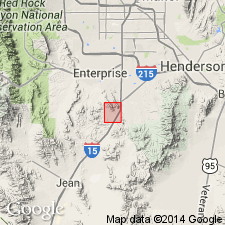
- Usage in publication:
-
- Anchor member*
- Modifications:
-
- Areal extent
- Redescribed
- Dominant lithology:
-
- Dolomite
- AAPG geologic province:
-
- Great Basin province
Summary:
Pg. 115-116, pl. 13. Anchor member of Monte Cristo dolomite. Described and mapped in Sloan district, southeastern Nevada, where it is 65 to 75 feet thick and consists of thin-bedded (2 to 18 inches), buff and pale-gray, dense, hard, fine- and medium crystalline dolomite with flattened, ovoid nodules of gray and tan chert in irregular layers. Overlies Dawn member and underlies Bullion member (both of Monte Cristo dolomite). Fossils; contains few poorly preserved specimens of SPIRIFER sp., fenestrellinid bryozoans and zaphrentid corals. Age is Mississippian.
Stratigraphic section on Sloan Hill 75 ft thick.
Source: US geologic names lexicon (USGS Bull. 1200, p. 94); GNU records (USGS DDS-6; Menlo GNULEX).
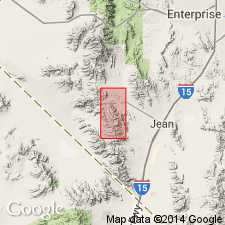
- Usage in publication:
-
- Anchor limestone member*
- Modifications:
-
- Mapped
- AAPG geologic province:
-
- Great Basin province
Summary:
Is structurally and lithologically described with maps and cross sections near each of mines in Yellow Pine district, NV. Maps indicate Mississippian age.
Source: GNU records (USGS DDS-6; Menlo GNULEX).
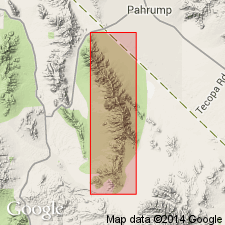
- Usage in publication:
-
- Anchor limestone member*
- Modifications:
-
- Areal extent
- AAPG geologic province:
-
- Great Basin province
Summary:
Pg. 880, 881, 883 (fig. 2); GSA Bull., v. 62, no. 12, pt. 2, p. 1503, 1951 [abs.]. Anchor limestone member of Monte Cristo limestone. Geographically extended into Nopah Range, Inyo County, southeastern California, where it consists essentially of limestone with minor amounts of shale and chert. Thickness 622 feet. Underlies Bullion limestone member; overlies Dawn limestone member (both of Monte Cristo limestone). Age is Early Mississippian (Osagean).
Source: US geologic names lexicon (USGS Bull. 1200, p. 94); GNU records (USGS DDS-6; Menlo GNULEX).
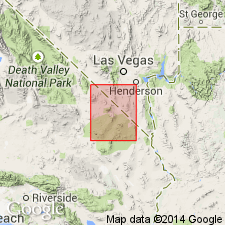
- Usage in publication:
-
- Anchor limestone member*
- Modifications:
-
- Areal extent
- AAPG geologic province:
-
- Great Basin province
Summary:
Pg. 42. Anchor limestone member of Monte Cristo limestone. Described in Ivanpah quadrangle (San Bernardino County, California, and Clark County, Nevada) where it is generally several thick layers of light-bluish-gray limestone that contain a number of layers of chert nodules. On Sloan Hill and near Standard mine it has been altered to dolomite. Overlies Dawn limestone member and underlies Bullion dolomite member (both of Monte Cristo limestone). Age is Early Mississippian, based on fossils [listed] identified by G.H. Girty in 1928 (Hewett field no. C17; USGS fossil loc. 5737; sec. 12, T. 17 N., R. 13 E., 4,000 ft northwest of benchmark 5236).
Source: Publication; US geologic names lexicon (USGS Bull. 1200, p. 94); GNU records (USGS DDS-6; Menlo GNULEX).
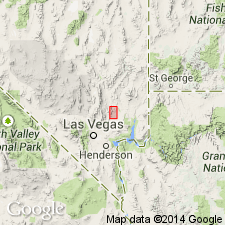
- Usage in publication:
-
- Anchor Limestone
- Modifications:
-
- Revised
- AAPG geologic province:
-
- Great Basin province
Summary:
Anchor Limestone Member of Hewett (1931) raised in rank to Anchor Limestone of Monte Cristo Group in Arrow Canyon Range, Clark Co, NV. Is 807 ft thick at Hidden Valley, 660 ft at Battleship Wash, and 250 ft thick at Bitter Spring Gap. Overlies Dawn Limestone. Contact with overlying Bullion Limestone arbitrarily placed at base of prominent, gray-weathering, massive, cliffy limestone. Age is Mississippian.
Source: GNU records (USGS DDS-6; Menlo GNULEX).
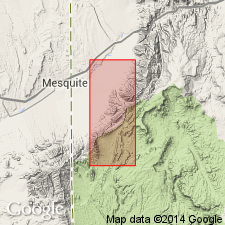
- Usage in publication:
-
- Anchor Member*
- Modifications:
-
- Areal extent
- AAPG geologic province:
-
- Plateau sedimentary province
Summary:
Extended into northwest Mohave Co, AZ, Plateau sedimentary province. [Extended from Muddy and northern Black Mountains, Clark Co, NV]. Is second from base of five members of Monte Cristo Limestone. Individual members were not separately mapped. Conformably overlies Dawn Member of Monte Cristo; conformably underlies Bullion Member of Monte Cristo. Age of unit not specified; age of Monte Cristo is Early and Late Mississippian.
Source: GNU records (USGS DDS-6; Denver GNULEX).
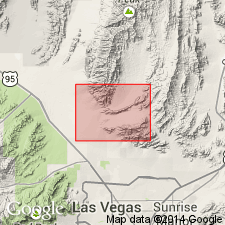
- Usage in publication:
-
- Anchor Limestone Member*
- Modifications:
-
- Areal extent
- AAPG geologic province:
-
- Great Basin province
Summary:
Anchor Limestone Member of Monte Cristo Limestone is geographically extended into report area (southern Sheep Range, Fossil Ridge, and Castle Rock area, Clark Co, NV). Age given as Early Mississippian.
Source: GNU records (USGS DDS-6; Menlo GNULEX).
For more information, please contact Nancy Stamm, Geologic Names Committee Secretary.
Asterisk (*) indicates published by U.S. Geological Survey authors.
"No current usage" (†) implies that a name has been abandoned or has fallen into disuse. Former usage and, if known, replacement name given in parentheses ( ).
Slash (/) indicates name conflicts with nomenclatural guidelines (CSN, 1933; ACSN, 1961, 1970; NACSN, 1983, 2005, 2021). May be explained within brackets ([ ]).

